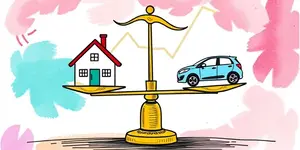Personal loans have become a cornerstone of modern financial planning, offering flexible funding for diverse needs without the necessity of collateral or complex underwriting. Whether you are dreaming of a home renovation, planning a wedding, consolidating debt, or facing an unexpected expense, a personal loan can provide the stability and clarity you need to move forward with confidence.
This detailed guide will explore everything from definitions and types to rates, eligibility criteria, and best practices for responsible borrowing.
Understanding Personal Loans
A personal loan is an installment credit product provided by banks, credit unions, or online lenders. You agree to repay the borrowed amount, plus interest, in fixed monthly installments over a set term.
Most personal loans are unsecured, meaning you do not need to pledge property as collateral. However, secured loan options are available for those who prefer lower interest rates and are willing to risk an asset.
- Unsecured Personal Loans: No collateral required; APR typically ranges from 6% to 36%.
- Secured Personal Loans: Require collateral like a car or savings; offer lower rates.
- Specialized Loans: Debt consolidation, emergency funding, home improvement, and more.
Interest Rates and Fees
Interest rates on personal loans vary widely based on lender type, credit history, and loan term. National averages for three-year terms hover around 12%, though rates can be as low as under 7% or as high as over 36%.
Credit unions often offer lower fees, making the APR almost identical to the base interest rate. Many banks assess origination fees, late fees, and prepayment penalties, so always review the fine print before committing.
When to Use a Personal Loan
Knowing the right moment to apply for a personal loan can save you money and stress. Use this tool when it aligns with your financial objectives and you can comfortably manage monthly repayments.
- Debt Consolidation with lower interest rates than credit cards: Combine multiple balances into one manageable payment.
- Large, Planned Expenses: Home renovations, weddings, major appliances, or education costs.
- Unexpected Emergencies: Urgent medical bills, vehicle repairs, or other unforeseen costs.
- Quick Funding Needs: Many lenders disburse funds within days of approval.
How Qualifying Works
Lenders evaluate several factors to determine your eligibility and interest rate. A strong application reduces borrowing costs and approval time.
Credit Score Matters: Scores above 690 typically secure the best rates. Borrowers with fair or poor credit can still apply but should expect higher APRs.
- Proof of income is required documentation: Pay stubs, tax returns, or benefit statements.
- Debt-to-Income Ratio: Keeping debt under 36% of monthly income strengthens your application.
- Identification and Bank Statements: Verify your identity and financial stability.
The Application Process
Applying for a personal loan is increasingly user-friendly, with online platforms offering rapid prequalifications and transparent rate comparisons.
Typical steps include filling out an application form, submitting required documents, and waiting for approval, which can take anywhere from a few hours to a couple of days. Once approved, funds are deposited directly into your account, often within 24 to 48 hours.
To ensure you get the best terms, compare multiple lenders, inquire about discounts for autopay setup, and never borrow more than you need or can repay.
Key Considerations Before Borrowing
Before taking on any debt, it is essential to assess the risks and rewards carefully. Personal loans can be powerful, but only when used responsibly.
Assess Your Budget: Ensure monthly payments fit comfortably within your financial plan without risking other obligations.
Understand Prepayment Terms: Some lenders impose penalties for early repayment, while others allow you to pay off the loan ahead of schedule without extra charges.
Impact on Credit: Timely payments boost your credit score, but missed or late payments can cause significant damage.
Summary Table: Types and Uses
Embracing Financial Confidence
Taking out a personal loan can feel daunting, but with thorough research and disciplined planning, it becomes a pathway to achieving life-changing goals. Whether you are consolidating debt, covering unforeseen expenses, or making a long-awaited purchase, a personal loan can bridge the gap between aspiration and reality.
Combining multiple debts into a single loan not only simplifies payments but can also save money in interest. Ultimately, the key to success lies in making informed decisions, understanding the full cost of borrowing, and remaining committed to your repayment plan.
By leveraging the insights in this guide, you can confidently navigate the personal loan landscape and unlock the potential of this versatile financial tool.
References
- https://www.nerdwallet.com/article/loans/personal-loans/personal-loan-types
- https://www.investopedia.com/personal-loan-5076027
- https://www.bankrate.com/loans/personal-loans/what-is-a-personal-loan/
- https://www.citi.com/personal-loans/learning-center/basics/types-of-personal-loans
- https://www.onemainfinancial.com/resources/loan-basics/different-types-of-personal-loans
- https://www.bankrate.com/loans/personal-loans/average-personal-loan-rates/
- https://www.bankrate.com/loans/personal-loans/documents-required-for-personal-loan/
- https://www.nerdwallet.com/article/loans/personal-loans/what-is-a-personal-loan










